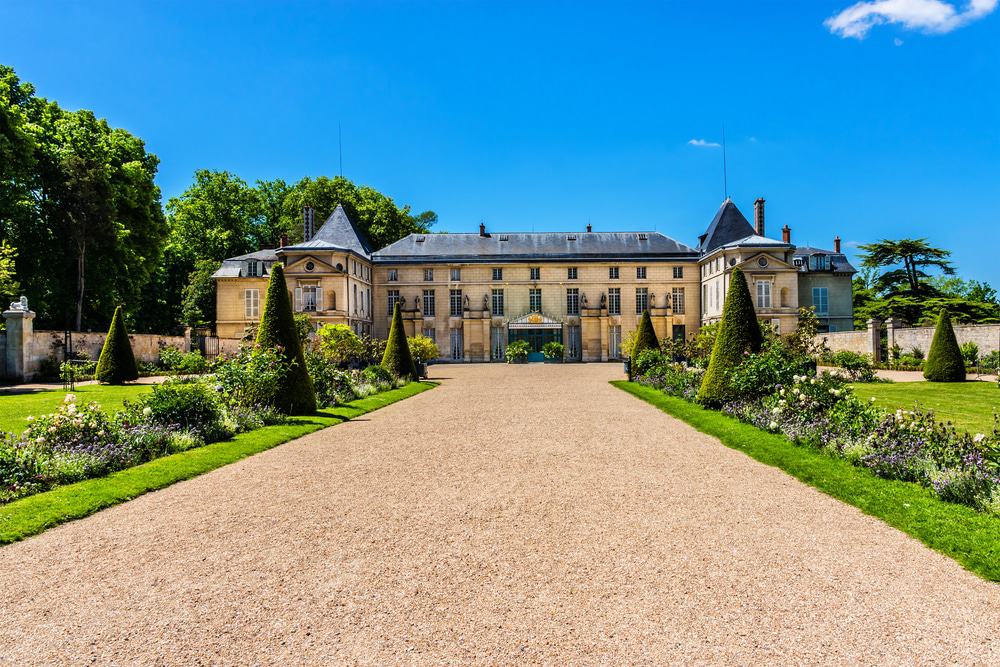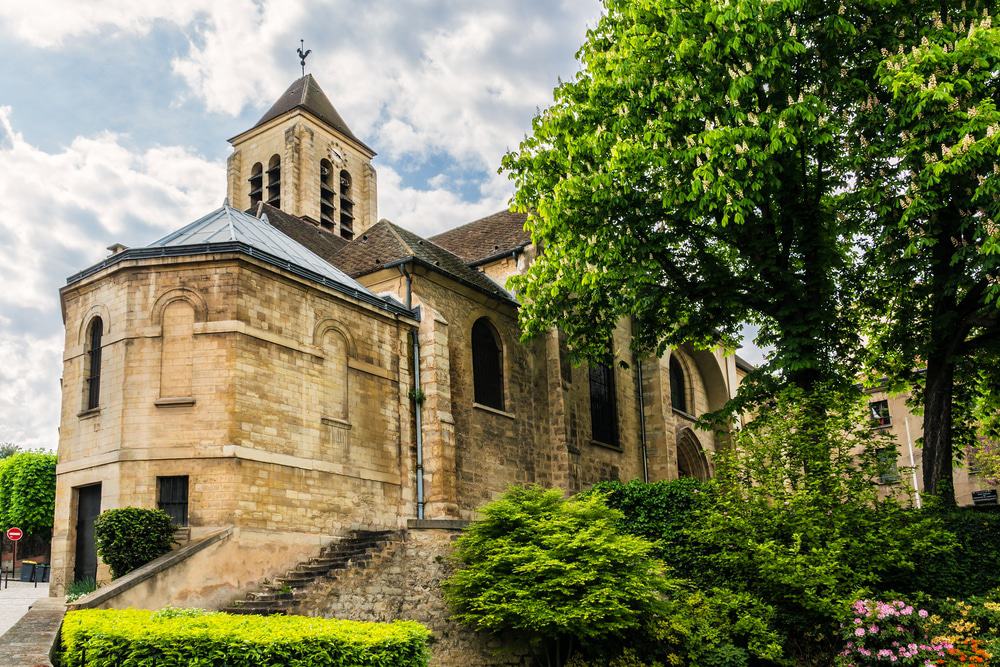A well-to-do western suburb of Paris, Courbevoie is in touch with the centre of the city, but has an easy, residential feel. There are some understated museums to check out, housed in pavilions that were made for the Exposition Universelle in 1878. Courbevoie also contains some of La Défense, the city’s modern banking district, so you won’t have to go far for dynamic urban architecture and France’s number one shopping mall.
And despite being in the suburbs, you’ll also have lightning-quick journey times to the centre of Paris on the Métro Line 1. For the sake of convenience we’ll deal with the things you can do in the west of Paris first.
Lets explore the best things to do in Courbevoie:
1. Musée Roybet Fould

Source: wikipedia
A forgotten fragment of Paris history, the venue for this museum is the wooden pavilion built by Norway and Sweden for the Exposition Universelle in 1878. It’s a fusion of the old and new, because it’s in a traditional Scandinavian-style house, while also standing as an early piece of prefab architecture.
The permanent displays inside are mostly from the time that the pavilion was built.
And as the museum’s name suggests these entail paintings by Ferdinand Roybet and Consuelo Fould.
On top of that there are paintings and sculptures by Jean-Baptiste Carpeaux, and lots of riveting little curios from the 19th century, like toys, dolls, postcards and posters.
2. Pavillon des Indes

Source: wikipedia
Also from the Exposition Universelle in 1878 is the Pavillon des Indes.
This enchanting pavilion was actually commissioned by the future Edward VII, then the Prince of Wales, to represent British India at the exhibition.
As with the Musée Roybet Fould pavilion it was originally set on the Champ de Mars in front of the Military Academy.
They were both transferred to Corbevoie’s Parc de Bécon in the 1880s where the Pavilion des Indes remains protected as a “monument historique”. After falling into disrepair the pavilion was restored in 2013 and reopened as an atelier and gallery for emerging young artists, together with a small exhibition about Courbevoie during the Third Republic.
3. Parc de Bécon

Source: commons.wikimedia
These pavilionss decorate the peaceful Parc de Bécon, which slopes down to the left bank of the Seine.
And there are a few other things to look out for: You can see the facade of the Charras Barracks, which housed the Swiss Guard, mercenaries that protected the King from the 17th century to the Revolution and were famously massacred at the Tuileries Palace.
You can also ponder the memorial to the National hero Maréchal Leclerc who died in a plane crash in 1947 and was posthumously awarded the title Marshal of France.
There’s a dreamy view of the river from the monument’s terrace.
4. Folie Saint James

Source: flickr
On the right bank of the Seine is a fun little souvenir from the Ancien Régime.
The Folie Saint-James is a house and Anglo-Chinese garden ordered by Claude Baudard de Saint James, the Treasurer of the French Navy in the late 1770s.
He gave the architect permission to do whatever he wanted, provided the it was expensive! And the outlandish result is a miniature mountain in the centre of the garden with rocks that would have been transported here at huge cost.
At the foot is a Doric temple and pond, and inside there used to be a network of tunnels covered with glimmering crystals.
5. La Défense

Source: Kiev.Victor / Shutterstock.com
A lot of Courbevoie’s high income residents make the short commute to Paris’ modern business district just next door.
La Défense came to life in the 1960s and grew over the next 30 years, adding the sort of futuristic skyscrapers that wouldn’t get planning permission in the centre of Paris.
New record-breaking structures are in the pipeline, but for now it’s a district to wander and get some photos of the eccentric architecture and sculptures.
If there’s a emblem for La Défense it’s the Grande Arche, a hollow cube-shaped building on an axis with the Arc de Triomphe several kilometres to the southeast.
6. Jardin d’Acclimatation

Source: shutterstock
By car or metro you won’t need more than a few minutes to get to this attraction on the northern cusp of the Bois de Boulogne.
This is music to children’s ears as they’ll be treated to rollercoasters, fairground rides, a miniature train, mini golf and animal attractions.
The Jardin d’Acclimatation was opened by Napoleon III in 1860 and still has an traditional air about it: There are landscaped gardens, many of the buildings go back to the 19th century and a lot of the entertainment is old-school and innocent, so think pony rides and puppet shows.
7. Fondation Louis Vuitton

Source: EQRoy / Shutterstock.com
Also on your doorstep is one of the newest cultural attractions in the city, and it’s pretty hard to miss.
The museum was designed by Frank Gehry, and despite only being here since 2014 has recently been transformed.
The vaulting canopies suspended over the main structure of the building have been given a multicoloured makeover by the French conceptual artist Daniel Buren.
The collection inside is enriched by works from the big names in contemporary art, like Gilbert & George, Jean-Michel Basquiat and Jeff Coons.
There are also installations by the likes of Olafur Eliasson and Ellsworth Kelly, as well as a permanent show about the project to construct this striking building.
8. Château de Malmaison

Source: shutterstock
Although you’ll be instinctively looking towards Paris for sightseeing, there’s also lots to see in the western outskirts.
If the traffic is quiet you can reach this outstanding Imperial palace in around ten minutes.
For a time at the start of the 19th century the château even shared the seat of the French government with the Tuileries, while it was Napoleon’s final residence before he went into exile after the 100 Days.
The woman who will forever be linked with Malmaison is Joséphine de Beauharnais, the first wife of Napoleon.
She lived at this property from 1799 up to her death in 1814, and invested huge amounts of cash on its grounds and interiors.
There’s a museum inside with the intimate personal effects of Joséphine and Napoleon.
9. Église Saint-Pierre-Saint-Paul

Source: shutterstock
And since you’re in the area you could also call in at this church close to the château.
It’s a fine if sober Renaissance building, but the attraction isn’t so much how it looks but the events that took place here and the memorials inside.
Joséphine passed away from pneumonia in 1814 and her funeral took place on 2 June that year.
The celebrated architect, Louis-Martin Berthault and sculptor Pierre Cartellier collaborated on her tomb.
You can also see the stunning mausoleum of her daughter Hortense, who was the mother of Napoleon III who ruled France in the Second Empire and commissioned this monument.
10. Local Markets
 Source: ville-courbevoie.fr
Source: ville-courbevoie.frThere are four markets in the Courbevoie area, trading five days a week.
Two of these, Marché Villebois Mareuil and Marché Charras are covered, while the Marché Marceau and Marché du Faubourg de l’Arche are open air.
All have butchers, bakers, confectioners, fishmongers, florists, cheese stands and sell traditional artisan products.
And they’re local institutions, preferred to supermarkets for a couple of reasons: First, what you buy comes straight from the farm, cutting out the middleman and making it fresher.
But also, the traders selling this produce are experts and will give you tips on how to store and cook whatever you buy from them.
11. Shopping in La Défense

Source: Takashi Images / Shutterstock.com
One of the world’s shopping and fashion capitals is a quick ride away on the Métro, but La Défense competes well in this respect too.
In fact it has the most visited shopping mall in France, Les Quatre Temps, which pulls in a staggering 50 million shoppers a year.
The size of this mall is also mind-boggling, with 300 stores over four levels for almost any popular brand you can name, from Sephora to Uniqlo.
And it goes without saying that all these shops are complemented by a whole directory of restaurants and leisure facilities including a 16-screen UGC cinema.
12. Bois de Boulogne

Source: shutterstock
If you’re visiting Courbevoie with children then the Jardin d’Acclimatation isn’t the only day out nearby.
You could venture into the enormous Bois de Boulogne, which is spread over 845 hectares.
Here, the Lac Inferieur offers boat rental, and you can row out to the island at the centre where there’s a monument to Napoleon III, who ordered the park’s transformation in the 1850s.
There’s also the Château de Bagatelle, a compact but cultivated hunting lodge for royalty when they were in the Bois de Boulogne.
The formal gardens are as refined as ever and even have peacocks roaming in them.
13. Parc de Saint-Cloud

Source: shutterstock
If you need one reason to hop on the Transilien and come to this park, it’s for the romantic panorama of Paris from the terrace at La Lanterne.
When the weather is clear you can pick out the individual landmarks on the horizon.
But there’s more besides the view: The gardens in the Parc de Saint-Cloud were plotted by none other than André Le Nôtre, who earned his place in history designing the grounds at Versailles.
This terraced parterre was for the royal Château de Saint-Cloud, obliterated in the Franco-Prussian War and now marked out by rows of yew topiaries.
14. Musée Marmottan Monet

Source: flickr
In the western 16th Arrondissement, on the other side of the Bois de Boulogne from Courbevoie, is the greatest Monet museum in the world.
And that is no exaggeration: In 1966 Michel Monet, the artist’s son , left his collection of his father’s works to the museum, instantly giving it the largest collection of Monet’s works anywhere.
What’s so special about this exhibition is that you can track every phase of Monet’s career, and see the epochal, Impression, Sunrise.
Michel Monet’s one of several donations in the 20th century that lavished impressionist art on the museum.
So Monet is accompanied by Renoir, Sisley, Degas, Manet, Signac, Pissarro and lots more.
15. Paris Sights

Source: shutterstock
So while we’ve dealt with everything close to Courbevoie, Paris isn’t far away either.
On Métro Line 1 you can be at the Arc de Triomphe in less than ten minutes, and the Place de la Concorde, the Tuileries and the Louvre in under 20. From there the city is at your complete disposal, whether you’d like to amble by the Seine, take a cruise to the Eiffel Tower, scale the iconic Notre-Dame or saunter along an elegant shopping passage.
But you can also overdose on culture at the Palais Garnier, Musée de l’Oranger, Musée d’Orsay and the Musée Rodin, all at your fingertips.
And although these are all must-dos, they’re also just the tip of the iceberg.




Thank you for your sharing. I am worried that I lack creative ideas. It is your article that makes me full of hope. Thank you. But, I have a question, can you help me?